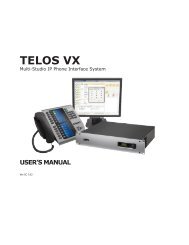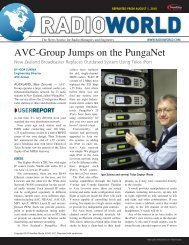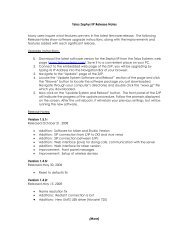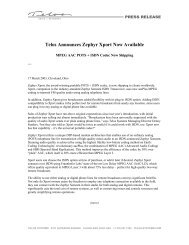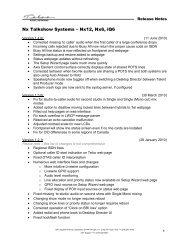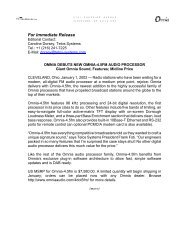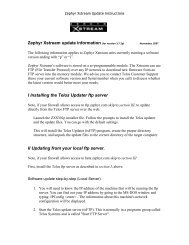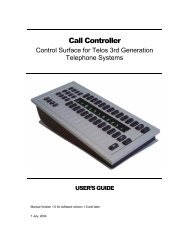NOW! 12-13 - Telos
NOW! 12-13 - Telos
NOW! 12-13 - Telos
You also want an ePaper? Increase the reach of your titles
YUMPU automatically turns print PDFs into web optimized ePapers that Google loves.
OMNIA | FM-STEREO TRANSMISSION | TECHNOLOGY ARTICLE<br />
52<br />
SSBSC<br />
FM-STEREO TRANSMISSION USING SINGLE<br />
SIDEBAND SUPPRESSED CARRIER (SSBSC) MODULATION<br />
ABSTRACT<br />
FM-Stereo transmission, employed in worldwide broadcasting,<br />
has been in place since 1961. The system uses double sideband<br />
suppressed carrier (DSBSC), within the multiplex baseband sig-<br />
nal, as means to transport the stereo sound ield to the receiver.<br />
This method, while robust and reliable, is prone to the effects<br />
of multipath. This paper will discuss an optional method utiliz-<br />
ing single sideband suppressed carrier (SSBSC) modulation as<br />
an alternative for broadcasters. SSBSC is backward compatible<br />
with existing radio receivers. Beneits which are perceptible to<br />
a listener include: a reduction in multipath induced distortion,<br />
additional protection to spectrum used for RBDS, SCA, and HD<br />
Radio ® signals. There is an additional, separate beneit in the re-<br />
ceiver which improves the signal-to-noise ratio when SSBSC is<br />
transmitted and the receiver is designed to capture the SSBSC<br />
signal. SSBSC for FM-Stereo has been deployed recently, under<br />
experimental authorization from the FCC, with ongoing testing in<br />
the lab, and in the ield.<br />
COMPETING FOR EVERY POSSIBLE LISTENER<br />
FM radio has a good ight on its hands. As a media transom to the<br />
public, it battles a multitude of additional delivery services like<br />
never before. Until recently, the competition was from television,<br />
phonograph records, compact discs, or tape. Actually FM-Stereo<br />
has outlived numerous media forms such as the long playing re-<br />
cord (LP), cassette and 8-track tape, mini-disc, soon the compact<br />
disc (CD), as well as a few others. Now, with the advent of good<br />
quality portable audio playback devices, and wireless streaming,<br />
there are many additional franchises available to steal the listen-<br />
er away from radio. What can FM radio do, technically, to improve<br />
sonic performance so a listener has less reason to abandon it as<br />
an outlet?<br />
HD Radio ® was introduced to the marketplace within the last<br />
ten years, and it’s still trying to make an impact on the casual<br />
listener. What’s needed, in the meantime, is an improvement to<br />
the existing infrastructure, which does not require any change or<br />
added expense to the listener. Within present day radio listening,<br />
FM is still the preferred choice. Recent technical research and de-<br />
velopment unveiled a unique way to improve the performance of<br />
FM-Stereo. What follows is the result of those efforts, along with<br />
a recommendation for FM broadcasting.<br />
SILVER ANNIVERSARY OF FM-STEREO<br />
In April of 2011, it marked 50 years since the Federal Communica-<br />
tions Commission (FCC) approved FM stereophonic transmission<br />
in the United States. The Commission, after evaluating fourteen<br />
proposals, decided upon a system that was of similar design from<br />
both Zenith and General Electric.<br />
The rules governing stereophonic performance have not been al-<br />
tered since the mid 1980’s (in the USA) when they were modiied<br />
to allow an additional 0.5% total modulation (maximum of 110%<br />
total), for every 1% of SCA modulation, when an SCA was being<br />
utilized. The rules governing the requirements of the FM-Stereo<br />
baseband signal are quite explicit, and leave little room for im-<br />
provement of the stereo transmission system.<br />
A quick refresher course on FM-Stereo transmission, courtesy of<br />
subpart 73, of the FCC Rules and Regulations:<br />
§ 73.322 FM stereophonic sound transmission standards.<br />
a. An FM broadcast station shall not use 19kHz +/-20Hz, ex-<br />
cept as the stereophonic pilot frequency in a transmission<br />
system meeting the following parameters:<br />
1. The modulating signal for the main channel consists of<br />
the sum of the right and left signals.<br />
2. The pilot subcarrier at 19kHz +/-2Hz, must frequency<br />
modulate the main carrier between the limits of 8 and<br />
10 percent.<br />
3. One stereophonic subcarrier must be the second har-<br />
monic of the pilot subcarrier (i.e., 38kHz) and must cross<br />
the time axis with a positive slope simultaneously with<br />
each crossing of the time axis by the pilot subcarrier. Ad-<br />
ditional stereophonic subcarriers are not precluded.<br />
4. Double sideband, suppressed-carrier, amplitude modula-<br />
tion of the stereophonic subcarrier at 38kHz must be used.<br />
5. The stereophonic subcarrier at 38kHz must be suppressed<br />
to a level less than 1% modulation of the main carrier.<br />
6. The modulating signal for the required stereophonic<br />
subcarrier must be equal to the difference of the left and<br />
right signals.<br />
7. The following modulation levels apply:<br />
i. When a signal exists in only one channel of a two<br />
channel (biphonic) sound transmission, modulation<br />
of the carrier by audio components within the base-<br />
band range of 50Hz to 15kHz shall not exceed 45%<br />
and modulation of the carrier by the sum of the am-<br />
plitude modulated subcarrier in the baseband range<br />
of 23kHz to 53kHz shall not exceed 45%.



